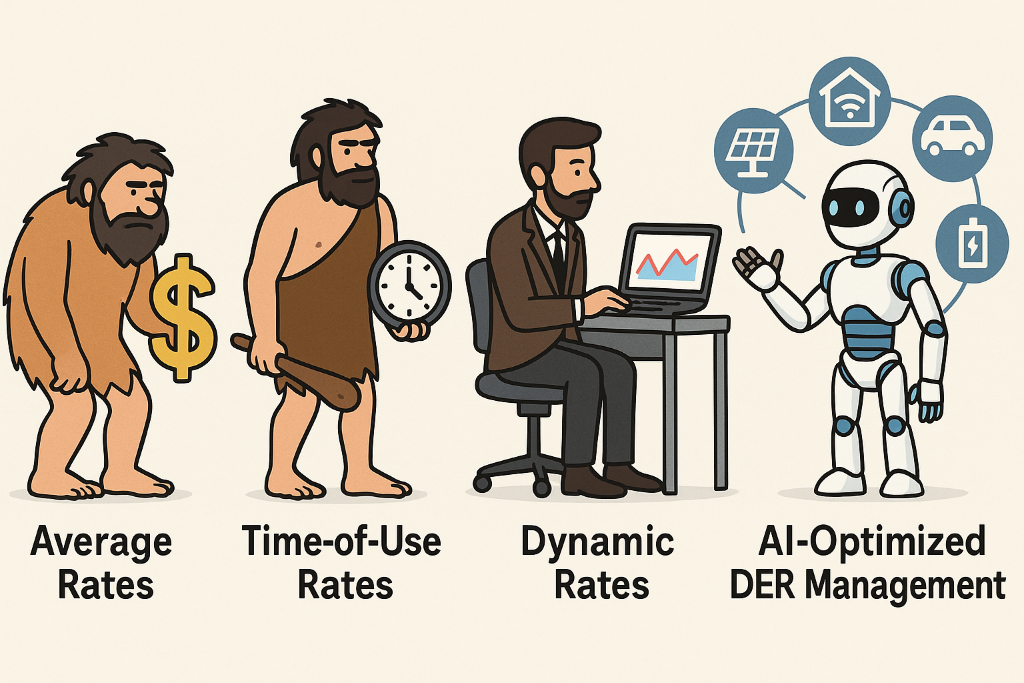
What if millions of electric vehicles (EVs), solar panels, and batteries could autonomously optimize energy flows—delivering unprecedented levels of grid stability, relieving congestion, avoiding costly infrastructure upgrades, and saving consumers billions? With AI-driven orchestration of distributed energy resources (DERs) and Vehicle-to-Everything (V2X) technology, this isn’t hypothetical. The potential is real and rapidly emerging—and it’s the key to building a resilient, decentralized grid.
V2X—particularly Vehicle-to-Grid (V2G) and Vehicle-to-Building (V2B)—is emerging as a powerful approach to improve grid management and optimize behind-the-meter energy usage. The substantial storage capacity in electric vehicles provides essential flexibility, which AI-driven systems can leverage to dynamically align energy consumption and exports with real-time, cost-based pricing signals. This powerful synergy unlocks unprecedented opportunities for substantial cost savings, enhanced grid resilience, and seamless integration and optimization of building energy use and DERs.
The Evolution Toward AI-Optimized, Behind-the-Meter Orchestration
Early in my career, I identified a significant issue in traditional electricity pricing: consumers generally face average rates, obscuring true economic signals crucial for efficient energy use choices. Electricity generation and delivery costs often vary dramatically by time of day and location on the grid, but these detailed signals rarely reach retail customers. My dissertation at the University of Delaware focused on the emerging distributed utility economic model, highlighting the untapped value that DERs can provide.
Despite significant progress in raising awareness of DER value among utilities and regulators, substantial opportunities remain to optimize these resources more fully. While many utilities have introduced time-of-use (TOU) rates, we’re only beginning to see broader interest in dynamic pricing. The California Public Utilities Commission (CPUC) has approved several dynamic rate pilot programs modeled after the CalFUSE (California Flexible Unified Signal for Energy) framework articulated in the 2022 CPUC white paper.
Dynamic rates and AI optimization are complementary technologies:
| Pricing Structure | Description |
| Average Rates | Offer minimal transparency and no incentives for consumers to optimize loads. |
| Time-of-Use (TOU) Rates | Provide basic, time-based pricing signals that encourage some load shifting. |
| Dynamic Rates | Include day-ahead or real-time price signals, more closely reflecting actual grid conditions. |
| AI-Optimized DER | Uses advanced data layers and algorithms to orchestrate EV charging, building loads, solar PV, and storage—creating value through seamless, automated decision-making. |
Dynamic rates primarily refer to pricing structures designed to reflect near real-time grid conditions—such as costs, supply, and demand—through explicit pricing signals. Consumers or automated systems then respond to these signals accordingly. AI-optimized DER management goes beyond simple responsiveness. It proactively coordinates energy consumption across multiple distributed resources—including EVs, storage, solar PV, and traditional backup systems—using AI-driven analytics and automated controls to deliver optimal economic and operational outcomes. This coordination is enabled by an application layer that sits above your energy assets—EVs, chargers, buildings, batteries, and solar—integrating once-fragmented systems into a unified platform that transforms raw data into a real-time energy command center.
The integration of AI with V2X technologies is no longer hypothetical—it’s happening now. Companies are actively developing solutions that combine intelligent energy management with bidirectional EV charging to unlock new forms of value for customers and the grid. My former employers, Nuvve and Fermata Energy, have both been at the forefront of this innovation, building platforms that enable vehicles to act as grid assets. More recently, companies like Kaasai are bringing fresh approaches by layering AI over diverse distributed energy assets, creating smarter, more adaptive systems for behind-the-meter optimization.
Rethinking Bonbright’s Principles for the AI Era
Traditional rate design principles articulated by James Bonbright—especially the emphasis on simplicity and understandability—have become outdated in the context of modern information technology. Today’s AI-enabled systems can manage complex pricing structures effortlessly, optimizing energy usage without requiring customers to understand or interact with the details. This challenges the long-standing notion that rate simplicity is essential for consumer acceptance. With AI, consumers can enjoy financial benefits and contribute to grid efficiency—automatically.
However, a key challenge in evaluating these emerging solutions lies in baselining: understanding the counterfactual—what would have happened without AI-optimized orchestration. Establishing this baseline is essential to proving that real economic value has been created. Pilot programs must therefore include robust measurement and verification frameworks that quantify the benefits of AI coordination across EVs, buildings, and other DERs. Only then can regulators and stakeholders gain confidence in the performance and scalability of these advanced approaches.
Overcoming Regulatory Lag
Despite the promise of these technologies, regulatory lag could hinder their full-scale deployment. Regulators and industry stakeholders must take bold, coordinated action to support innovation by embracing dynamic pricing, transactive energy models, and AI-enabled DER orchestration. Modernizing rate design, incentivizing utility investments in upgrading IT systems and data infrastructure platforms, and enabling market access for flexible resources are all essential steps to unlock the full potential of the rapidly growing array of grid-edge assets shaping the future of energy.
Key Action Steps
Stakeholders should prioritize the following to catalyze the development and scaling of AI-optimized V2X systems:
- Pilot Programs and Demonstrations: Launch real-world pilots combining AI-driven dynamic pricing with V2X technologies.
- Clear Scaling Strategies: Develop structured pathways from pilots to full-scale deployment, supported by regulatory certainty.
- Regulatory Modernization: Update rate structures and encourage utility investments in modern grid infrastructure and data platforms.
- Education and Outreach: Proactively inform policymakers, regulators, and the public on the benefits of AI-enhanced DER orchestration.
Final Thought: Don’t Wait
The tools are advancing, and the technology is rapidly emerging. What we need now is regulatory courage and industry coordination. Let’s stop treating AI and V2X as distant concepts and start approaching them as the grid solutions with significant near-term potential—with deliberate action, testing, and scaling.
Let’s act.